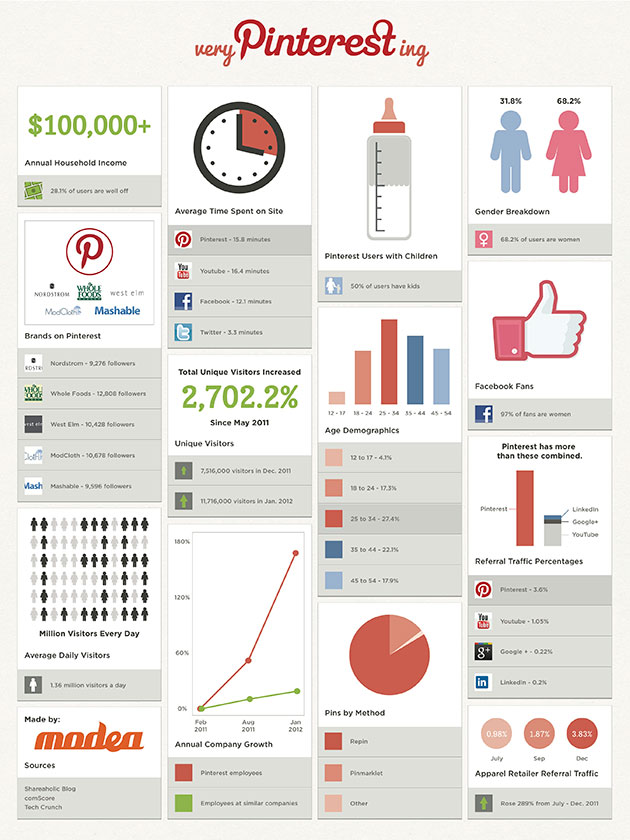Pinterest is a social bookmarking site in which users share images such as photos, videos, quotes and infographics by “pinning” them to a theme-based virtual pinboard. The site started with a closed beta in Spring 2010 and has since been running in an invitation-only open beta. In February 2012, ComScore reported that Pinterest had over 10 million unique visitors each month. And according to a recent report from Experian, “Pinterest is now the 3rd most popular social networking site behind Facebook and Twitter.” Modea reports that 68% of Pinterest users are women (half have children), 28.1% of users have an average household income over $100,000 and over 27% of users are between the ages of 25 and 34. Check out this cool infographic from Modea regarding Pinterest users:

Pinterest itself promotes the site to “organize and share all the beautiful things you find on the web. People use pinboards to plan their weddings, decorate their homes, and organize their favorite recipes.” When users see an image they want to pin, they click on a “Pin It” button they’ve added to their browser. All the images on the page they were visiting will be listed and the user simply clicks on the one they want to pin and creates or selects a pinboard to pin to.
Pinterest for Marketers
For retail brands, Pinterest is, according to DemandGen Report “a natural fit.” Since the majority of users are moms who shop, this makes sense. In January 2012, Sharaholic reported that Pinterest drove more referral traffic to retailers than Google Plus, YouTube and LinkedIN combined. Examples of brands with impressive Pinterest sites are Lowes, Whole Foods, and Nordstrom.
Even though business buyers are not likely on Pinterest yet, B2B brands are jumping on the Pinterest bandwagon. Other than the fact it’s free, benefits for B2B companies from experimenting with Pinterest now include:
- securing your Pinterest “handle” before someone else does. Recall the domain name wars of the early Web days. For instance, I tried to find REI but only found someone named REI Wang: pinterest.com/REI. But after searching more I found it under http://pinterest.com/source/rei.com/
- boosting Search Engine Optimization (SEO) results by driving more traffic to websites and offer-specific landing pages
- increasing views of videos, infographics and photos already developed
- showcasing your brand – making your company cool and a fun place to work or do business with
- intelligence gathering – see who is pinning your content and who among your competitors they are pinning
In DemandGen Report’s article, Pinterest And B2B Marketing: Pinning Down The Newest Social Media Player, HubSpot’s Inbound Marketing Manager, Magdalena Georgieva, stated “In the last six months we attracted close to 6,000 visits from Pinterest and just over 4,000 visits from Google+,”. “We used our marketing analytics to look at the number of leads these channels brought us, and it’s about 850 from Pinterest and about 350 from Google+.” Other B2B companies with a presences on Pinterest include Cisco Systems, Oracle, Intel, and Salesforce.com. The Salesforce site includes pinboards for Infographics, Killer Slides, I Love Working at Salesforce, Around the Salesforce Office and Customer Success Stories.
If you plan to experiment with Pinterest for B2C or B2B marketing, here is a checklist of to do items:
- Add a Pin It button to your browser so you can pin content your own or other websites.
- Add Pinterest buttons to your website so visitors can pin content to their own boards and follow you.
- Request an invitation to join Pinterest. It may take a while to get approved.
- Post useful, educational or entertaining content, don’t just sell. Show your brands personality like Salesforce.com does.
- Be creative. Create infographics to visually show statistics. Make sure images and videos are visually appealing.
- Include hash tags so people can find your content when they search.
- Follow others and they may follow you back.
- Measure results using tools such as Google Analytics to gauge how much, if any, traffic your site is getting from Pinterest.
- Optimize – continue to experiment to improve results.
Final thoughts: Make a commitment. Like starting a blog or any other social media marketing tactic, it takes effort to keep it going. Have fun, be creative and remember the old adage “a picture is worth a thousand words” or perhaps “a Pin is worth a thousand words.”

